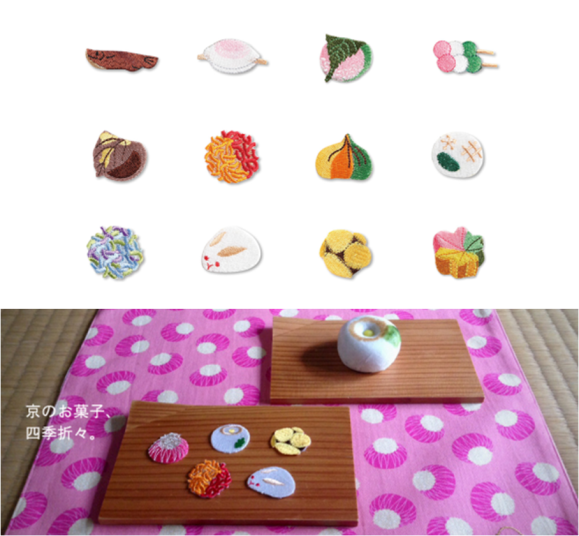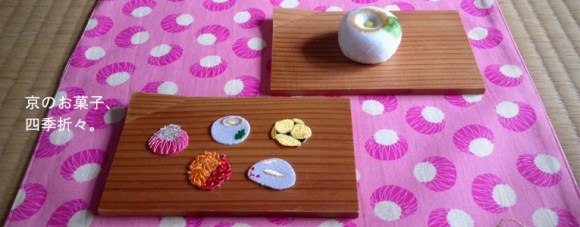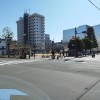
How well do you know your wagashi (Japanese sweets)? If you’re struggling to put a name to any of the traditional delectables pictured above, there’s a store in Kyoto that can help.
By creating decorative embroidered versions of some of Japan’s most popular confections, Kyoto-based Kyototo is giving us an education in the names and background of the hand-crafted treats that are often seasonal but always delicious. Come with us as we take a look at twelve of the most beautiful wagashi you can find in Japan.
▼ From left to right: waka-ayu (young ayu), hanabira mochi (flower petal rice cake), sakura mochi (cherry blossom rice cake), hanami dango (flower-viewing dumplings)
Waka-ayu (also known as ayu-gashi) is a waffle-like confection filled with sweet mochi (sticky rice cake) and shaped like the river fish called ayu. This is a very popular confection in early summer.
Hanabira mochi is a rice cake which is folded over sweet bean paste and candied burdock root. The auspicious colour combination of red and white means this is usually eaten at the beginning of the year.
Sakura mochi is a rice cake filled with sweet beans and wrapped in salted cherry leaves. While varieties differ between the Kanto and Kansai regions, sakura mochi is commonly eaten in spring and is a particularly popular treat for Hina Matsuri/Girls’ Day, celebrated on March 3 (sakura mochi has also been the inspiration for a unique craft beer).
Hanami dango is another springtime sweet, with each colour representing different seasons: red for spring flowers, white for the thawing winter snow, and green for the leaves of the coming summer. Some people say the colours represent spring scenes: cherry blossoms, spring haze, and grasses.
▼ From left to right: kogarashi (cold, wintry wind), kinshu (red and yellow autumn leaves), kuri shibori (pressed chestnut), oribe manju (Oribe steamed bun)
Kogarashi is a traditional winter sweet. Usually served with powdered green matcha tea, this is a sweet paste wrapped up in kneaded dough which is shaped into a withered, brown leaf.
Kinshuu is commonly served in autumn, with its red, yellow and orange coating resembling the brilliant colours of falling leaves.
Kuri shibori is a chestnut paste which has been squeezed in a cloth to give it its distinctive chestnut shape. It perfectly captures the taste of autumn.
Oribe manju is actually named after a man called Oribe, who worked for the famous tea ceremony master Senrikyu. This sweet bun is decorated with a sweep of green colour to reflect his love of a similar-looking glaze pattern on pottery.
▼ From left to right: ajisai (hydrangea), usagi manju (rabbit steamed bun), kuri kanoko (pressed chestnut), koyo (autumn leaves)
Ajisai, or hydrangeas, have been blooming across Japan for centuries. Blue, purple and light-green bean pastes are shaped into a ball and served during the June rainy season.
Usagi manju are adorable little red-eyed bunnies filled with a smooth bean paste and often served at moon-viewing events.
Kuri kanoko takes its name from its outer pattern, which resembles the back of a fawn. Sweet, glossy chestnuts from Kyoto cover a bean paste ball.
Koyo refers to the brilliantly coloured autumn leaves, but the most spectacular example can be seen with momiji, or maple leaves. Kneaded dough is shaped into a maple leaf, using molds which differ from shop to shop.
Now you can take your favourite wagashi home to keep forever in the form of an adorable embroidery badge. Priced from 324 to 410 yen (US$2.71-$3.43) each, and available to order from Kyototo’s website here, these make for an ideal souvenir. The best thing about them? We can collect them all without having to worry about counting calories!





 Eight great Japanese sweets for celebrating Wagashi Day (or just for celebrating today)!
Eight great Japanese sweets for celebrating Wagashi Day (or just for celebrating today)! Studio Ghibli serves up My Neighbour Totoro with a side of traditional Japanese wagashi sweets
Studio Ghibli serves up My Neighbour Totoro with a side of traditional Japanese wagashi sweets We tried making traditional Japanese sweets at home then had some fun with the leftovers
We tried making traditional Japanese sweets at home then had some fun with the leftovers Love Japanese yokai? You’ll love these Halloween-only yokai Japanese confectionaries
Love Japanese yokai? You’ll love these Halloween-only yokai Japanese confectionaries Enjoy beautiful Japanese snacks and tea at Saryo Fukucha in Kyoto
Enjoy beautiful Japanese snacks and tea at Saryo Fukucha in Kyoto Pizza Hut Japan’s hot lucky bags are perfect for a New Year’s pizza party
Pizza Hut Japan’s hot lucky bags are perfect for a New Year’s pizza party 7 great places to see Mt. Fuji from without having to climb it
7 great places to see Mt. Fuji from without having to climb it Japan now has potato chip-covered chocolate, and it’s amazing!【Taste test】
Japan now has potato chip-covered chocolate, and it’s amazing!【Taste test】 Japan’s new Pokémon donuts are here, so let’s eat Pikachu, Chansey, and some Poké Balls【Photos】
Japan’s new Pokémon donuts are here, so let’s eat Pikachu, Chansey, and some Poké Balls【Photos】 Japanese manhole covers become a hit with foreign tourists in off-the-beaten path Tokyo area
Japanese manhole covers become a hit with foreign tourists in off-the-beaten path Tokyo area 7-Eleven Japan’s ramen-cooking robot whipped us up a bowl of noodles【Taste test】
7-Eleven Japan’s ramen-cooking robot whipped us up a bowl of noodles【Taste test】 Don’t forget that the best convenience store in northern Japan has branches farther south too
Don’t forget that the best convenience store in northern Japan has branches farther south too How to cook rice in a Ziploc container【SoraKitchen】
How to cook rice in a Ziploc container【SoraKitchen】 Japanese burger chain releases epic tofu burgers, designed by customers
Japanese burger chain releases epic tofu burgers, designed by customers Japanese fish that beat Pokémon Sapphire are retiring from video game streaming【Video】
Japanese fish that beat Pokémon Sapphire are retiring from video game streaming【Video】 Starbucks Japan ready to get Year of the Horse started with adorable drinkware and plushies【Pics】
Starbucks Japan ready to get Year of the Horse started with adorable drinkware and plushies【Pics】 Lacquerware supplier to emperor of Japan and Pokémon team up for new tableware
Lacquerware supplier to emperor of Japan and Pokémon team up for new tableware Cyberpunk anime meets traditional culture in Ghost in the Shell gold leaf Japanese changing screens
Cyberpunk anime meets traditional culture in Ghost in the Shell gold leaf Japanese changing screens Japan may add Japanese language proficiency, lifestyle classes to permanent foreign resident requirements
Japan may add Japanese language proficiency, lifestyle classes to permanent foreign resident requirements Hello Kitty Choco Egg figures are an adorable trip through three periods of Japanese pop culture【Pics】
Hello Kitty Choco Egg figures are an adorable trip through three periods of Japanese pop culture【Pics】 Japan’s otoshidama tradition of giving kids money at New Year’s gets a social welfare upgrade
Japan’s otoshidama tradition of giving kids money at New Year’s gets a social welfare upgrade Starbucks Japan releases new zodiac chilled cup drink for 2026
Starbucks Japan releases new zodiac chilled cup drink for 2026 Can a dirty butthole make you filthy rich in Japan? We’re starting a New Year’s lottery experiment
Can a dirty butthole make you filthy rich in Japan? We’re starting a New Year’s lottery experiment 7-Eleven Japan starts new temporary luggage storage service in over 300 branches
7-Eleven Japan starts new temporary luggage storage service in over 300 branches Disillusionment at Tsukiji’s tourist-target prices led us to a great ramen restaurant in Tokyo
Disillusionment at Tsukiji’s tourist-target prices led us to a great ramen restaurant in Tokyo Starbucks teams up with 166-year-old Kyoto doll maker for Year of the Horse decorations【Photos】
Starbucks teams up with 166-year-old Kyoto doll maker for Year of the Horse decorations【Photos】 Tokyo considering law requiring more trash cans following litter increase in heavily touristed area
Tokyo considering law requiring more trash cans following litter increase in heavily touristed area Tokyo’s Tsukiji sushi neighborhood asks tour groups to stay away for the rest of the month
Tokyo’s Tsukiji sushi neighborhood asks tour groups to stay away for the rest of the month Nintendo’s Kirby now delivering orders at Kura Sushi restaurants, but not in Japan
Nintendo’s Kirby now delivering orders at Kura Sushi restaurants, but not in Japan Tokyo event lets you travel back in time, for free, to celebrate 100 years since Showa era start
Tokyo event lets you travel back in time, for free, to celebrate 100 years since Showa era start Sanrio theme park in Japan announces plans to expand into a Sanrio resort
Sanrio theme park in Japan announces plans to expand into a Sanrio resort Stamina-destroying “Paralysis Noodles” are Tokyo’s newest over-the-top ramen innovation
Stamina-destroying “Paralysis Noodles” are Tokyo’s newest over-the-top ramen innovation Survey asks foreign tourists what bothered them in Japan, more than half gave same answer
Survey asks foreign tourists what bothered them in Japan, more than half gave same answer Japan’s human washing machines will go on sale to general public, demos to be held in Tokyo
Japan’s human washing machines will go on sale to general public, demos to be held in Tokyo Japan’s deadliest food claims more victims, but why do people keep eating it for New Year’s?
Japan’s deadliest food claims more victims, but why do people keep eating it for New Year’s? We deeply regret going into this tunnel on our walk in the mountains of Japan
We deeply regret going into this tunnel on our walk in the mountains of Japan Studio Ghibli releases Kodama forest spirits from Princess Mononoke to light up your home
Studio Ghibli releases Kodama forest spirits from Princess Mononoke to light up your home Major Japanese hotel chain says reservations via overseas booking sites may not be valid
Major Japanese hotel chain says reservations via overseas booking sites may not be valid Put sesame oil in your coffee? Japanese maker says it’s the best way to start your day【Taste test】
Put sesame oil in your coffee? Japanese maker says it’s the best way to start your day【Taste test】 No more using real katana for tourism activities, Japan’s National Police Agency says
No more using real katana for tourism activities, Japan’s National Police Agency says Starbucks Japan reveals new sakura drinkware collection, inspired by evening cherry blossoms
Starbucks Japan reveals new sakura drinkware collection, inspired by evening cherry blossoms Updated cherry blossom forecast shows extra-long sakura season for Japan this year
Updated cherry blossom forecast shows extra-long sakura season for Japan this year We spend a morning with an expert wagashi chef creating no-bake traditional Japanese sweets!
We spend a morning with an expert wagashi chef creating no-bake traditional Japanese sweets! We eat Japan’s oldest sweet, available at only one store in all of Japan
We eat Japan’s oldest sweet, available at only one store in all of Japan Take bites of the Milky Way and summer with traditional, Tanabata-inspired Japanese sweets【Pics】
Take bites of the Milky Way and summer with traditional, Tanabata-inspired Japanese sweets【Pics】 Japanese convenience store chain adds Neo Wagashi sweets to its lineup
Japanese convenience store chain adds Neo Wagashi sweets to its lineup Pokémon and 158-year-old Kyoto sweets shop team up for Pokémon wagashi confectionery line【Pics】
Pokémon and 158-year-old Kyoto sweets shop team up for Pokémon wagashi confectionery line【Pics】  You can enjoy traditional Japanese New Year’s osechi eats on a budget with Lawson Store 100
You can enjoy traditional Japanese New Year’s osechi eats on a budget with Lawson Store 100 Cute Kyoto! We Taste Hidden Delights From a Traditional Sweet House in Pontocho
Cute Kyoto! We Taste Hidden Delights From a Traditional Sweet House in Pontocho One Piece anime character now appears as Japanese wagashi tea ceremony sweet
One Piece anime character now appears as Japanese wagashi tea ceremony sweet 15 beautiful Japanese sweets to cool you down this summer
15 beautiful Japanese sweets to cool you down this summer New Japanese KitKats capture the flavour of a busy port city
New Japanese KitKats capture the flavour of a busy port city Matcha parfait ice cream bars: Kyoto tea store deconstructs parfaits, creates stunning new sweets
Matcha parfait ice cream bars: Kyoto tea store deconstructs parfaits, creates stunning new sweets We became Japanese sweet chefs for a day with Popin Cooking’s DIY wagashi set
We became Japanese sweet chefs for a day with Popin Cooking’s DIY wagashi set “Drunk Taiyaki” turns traditional Japanese sweet into an amazing new tipple
“Drunk Taiyaki” turns traditional Japanese sweet into an amazing new tipple Our interest spikes as Haikyu head anime sweets arrive in Japanese convenience stores【Taste test】
Our interest spikes as Haikyu head anime sweets arrive in Japanese convenience stores【Taste test】 Our search for Kyoto Station’s cheapest souvenir reveals a surprisingly sweet find
Our search for Kyoto Station’s cheapest souvenir reveals a surprisingly sweet find This Japanese sweets shop specializes in beautiful flower-shaped ohagi rice cakes
This Japanese sweets shop specializes in beautiful flower-shaped ohagi rice cakes
Leave a Reply